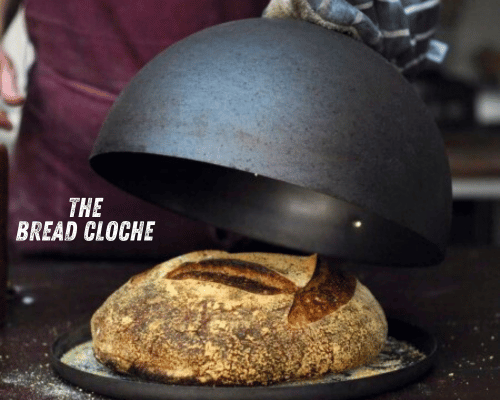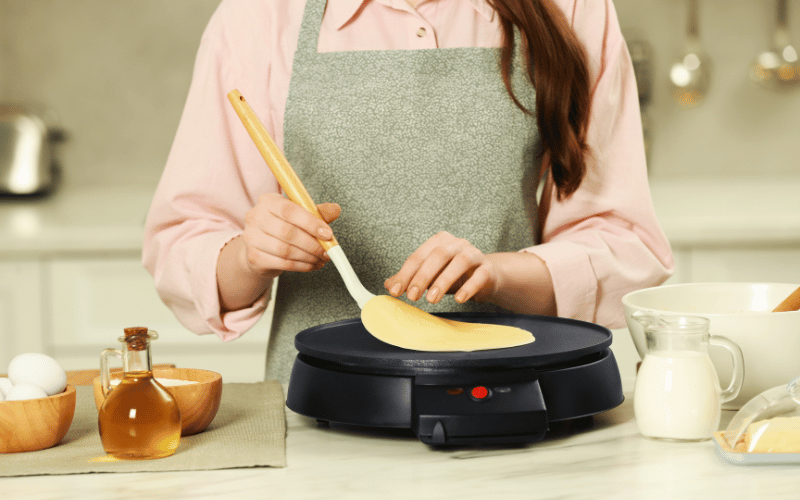As any baker knows, achieving that perfect crust and crumb requires not only skill but also the right tools. In this comprehensive comparison, we delve into two renowned contenders in the artisan bread-baking realm: the Bread Cloche and the Dutch Oven. These versatile tools have gained popularity among home bakers for their ability to create stunning loaves with delightful characteristics. With their heat-retaining properties and unique designs, these baking vessels promise to elevate your bread-making experience. Join us as we explore the strengths and nuances of each tool, empowering you to make an informed decision and take your artisan bread baking to new heights.
About The Bread Cloche

Bread Cloche is a specialized baking tool designed to replicate the effects of a traditional brick oven in a home kitchen setting. It consists of a round or oval-shaped, thick ceramic or clay base and a domed lid that encloses the bread during baking. The Bread Cloche works by creating a micro-environment within its enclosed space, trapping steam released from the dough during the initial stages of baking. This trapped steam creates a moist and humid atmosphere, which enhances the bread’s crust development and promotes oven spring, resulting in a beautiful, artisan-style loaf.
Using a Bread Cloche offers several advantages for artisan bread baking. Firstly, the enclosed space provides optimal steam retention, leading to a crispy and caramelized crust. The lid’s dome shape allows for ideal airflow, ensuring even heat distribution and consistent baking. The Bread Cloche’s porous material also contributes to moisture regulation, preventing excessive drying of the bread while maintaining the right level of crust texture.
Additionally, the preheated Cloche facilitates a rapid start to baking, which enhances the oven spring and creates an open crumb structure. By harnessing the Bread Cloche’s unique properties, bakers can achieve professional-level results in their homemade artisan bread baking endeavors.
About Dutch Oven

The Dutch Oven is a versatile and time-honored cooking vessel, renowned for its exceptional heat retention and even distribution. Traditionally made of cast iron, it features thick walls and a tight-fitting lid that effectively seals in moisture during cooking. In recent years, enameled cast iron Dutch Ovens have become popular due to their ease of maintenance. When used for baking bread, the Dutch Oven serves as a makeshift steam chamber, emulating the professional steam injection systems found in commercial bakeries. The trapped steam within the Dutch Oven creates the ideal environment for artisan bread baking, promoting excellent crust development and a well-risen loaf.
Using a Dutch Oven for artisan bread recipes offers numerous benefits. Its superb heat retention ensures consistent and even baking, resulting in a perfectly crisp crust. The sealed environment traps moisture, enhancing oven spring and providing the bread with a tender crumb and a beautifully open texture.
Moreover, the Dutch Oven’s versatility allows bakers to experiment with various bread recipes, from classic sourdough to whole-grain loaves. Its adaptability extends to other cooking techniques, making it an indispensable tool in any kitchen. The Dutch Oven’s ability to deliver professional-grade results, combined with its versatility, makes it a favorite choice for home bakers seeking artisan-style bread without the need for specialized equipment.
Comparison of Key Features
Heat Retention and Distribution
When it comes to heat retention and distribution, both the Bread Cloche and the Dutch Oven excel in their unique ways.
Bread Cloche: The Bread Cloche’s thick ceramic or clay material boasts excellent heat retention. It preheats thoroughly, maintaining a stable and high baking temperature throughout the process. The Cloche’s enclosed design locks in steam, creating a moist environment conducive to a crispy and well-browned crust. The even heat distribution ensures uniform baking, promoting consistent rise and a beautifully golden crust.
Dutch Oven: The cast iron construction of the Dutch Oven is renowned for its exceptional heat retention properties. Preheated in the oven, it becomes a potent heat chamber. When the bread is placed inside, the sealed environment preserves the moisture, encouraging oven spring and caramelization of sugars, leading to a rustic, thick, and crunchy crust. However, due to its shape, the heat may not disperse as evenly as a Bread Cloche, resulting in a slightly thicker crust around the edges of the loaf.
Crust Texture
The choice of baking vessel significantly influences the texture of the bread crust.
Bread Cloche: The Bread Cloche’s steam-trapping capabilities create a humid environment that promotes rapid and early crust formation. This contributes to a thin and delicate crust, making it ideal for those who prefer a lighter, crackling texture. The enclosed space also helps retain moisture, resulting in a softer and more tender crumb.
Dutch Oven: The Dutch Oven’s sealed environment locks in steam, encouraging a thicker and chewier crust. The intense heat chamber promotes faster caramelization and browning, yielding a deeply colored and robust crust. The Dutch Oven’s crust is known for its signature crackling sound when freshly removed from the oven, and its thickness contributes to a longer-lasting crust that remains crisp for longer periods.
So, both the Bread Cloche and the Dutch Oven offer distinct advantages in artisan bread baking. The Bread Cloche excels in even heat distribution and yields a thinner, lighter crust with a soft crumb. On the other hand, the Dutch Oven’s excellent heat retention results in a thicker, chewier crust and a more intense browning effect. The choice between the two tools ultimately depends on personal preferences, baking goals, and the desired crust texture for each individual baker’s perfect artisan bread.
Pros and Cons of Bread Cloche
Pros
- Excellent heat retention and even distribution for consistent baking results.
- Traps and retains steam, promoting a crispy and caramelized crust.
- Facilitates rapid oven spring, creating an open and airy crumb structure.
- Provides a controlled baking environment for artisan-style loaves.
- Versatile and easy to use, suitable for various bread recipes.
- Enhances the oven spring and crust development of gluten-free bread.
Cons
- Limited loaf size due to the cloche’s enclosed design.
- Hefty initial investment compared to regular baking pans.
- Requires careful handling due to the ceramic or clay material’s fragility.
- Longer preheating time compared to other baking vessels.
- Limited availability and higher cost for some specialty Bread Cloches.
- May not fit certain unconventional bread shapes.
Pros and Cons of Dutch Oven
Pros
- Excellent heat retention and distribution for consistent baking results.
- Creates a steam chamber, yielding a thick and crispy crust.
- The enclosed environment enhances the oven spring and rise.
- A versatile tool is suitable for baking bread and other cooking methods.
- Widely available in various sizes and styles, offering options for different bread sizes.
- Durable and long-lasting, providing value for money.
- No need for additional steam-generating equipment.
Cons
- Heavy and cumbersome to handle, especially when hot.
- Limited loaf size based on Dutch Oven dimensions.
- The narrow opening may make it challenging to place the dough inside without deflating.
- Requires preheating, which can add to the overall baking time.
- Careful handling is needed to avoid steam burns while removing the lid.
- The Dutch Oven’s cast iron material may require special cleaning and maintenance.
Baking Results and Testimonials
Bread Cloche Testimonials
Home bakers who have used the Bread Cloche rave about the outstanding baking results it delivers. They praise the Cloche’s ability to produce artisan-quality loaves with a crispy crust and an open, airy crumb. Many users admire the ease of use and how the Cloche facilitates rapid oven spring, resulting in professional-looking loaves.
Some testimonials highlight the versatility of the Bread Cloche, accommodating a range of bread recipes, including gluten-free options. Bakers appreciate the consistent and even heat distribution, ensuring a perfectly baked loaf every time. Overall, Bread Cloche users express satisfaction with the excellent baking performance and the authentic artisanal touch it brings to their homemade bread.
Dutch Oven Testimonials
Enthusiastic home bakers who have employed the Dutch Oven for bread baking commend its remarkable results. They admire the Dutch Oven’s ability to create a thick, crusty crust with a signature crackle and beautiful caramelization. Users share their excitement over the outstanding oven spring and how the Dutch Oven replicates the results of professional bakeries.
Many testimonials appreciate the Dutch Oven’s versatility, using it not only for bread but also for other cooking needs. While some users highlight the Dutch Oven’s sturdy build and durability, others praise its role in transforming their baking experience, leading to a newfound passion for artisan bread making. These testimonials showcase the Dutch Oven’s capacity to deliver exceptional baking outcomes and inspire baking enthusiasts to experiment with various bread recipes.
Suitability for Different Bread Recipes
Bread Cloche Baking
The Bread Cloche is exceptionally well-suited for baking a wide range of bread recipes, especially those that benefit from a crispy crust and open crumb structure. Artisan-style bread, such as rustic sourdough, French baguettes, and ciabatta, thrive in the Bread Cloche’s enclosed and steam-retaining environment.
Additionally, bread with higher hydration levels, like focaccia and ciabatta, achieve superb results due to the Cloche’s ability to maintain the ideal moisture balance during baking. Moreover, gluten-free breads, which often require a controlled baking environment, turn out beautifully in the Bread Cloche, achieving a satisfying crust and tender crumb.
Dutch Oven Baking
The Dutch Oven is equally versatile when it comes to baking various bread recipes. Bread that benefits from a thick, crackling crust, such as no-knead artisan loaves, country boules, and hearty whole-grain bread, excels in the Dutch Oven’s steam-rich environment. Additionally, enriched breads like brioche and challah, which require optimal oven spring and browning, achieve excellent results.
The Dutch Oven’s heat retention and intense caramelization make it an ideal choice for baking multigrain and seed-studded bread, enhancing its flavors and textures. Whether baking classic loaves or experimenting with specialty bread, the Dutch Oven proves to be an excellent tool for achieving exceptional results in the home kitchen.
Factors to Consider When Choosing the Right Tool
When choosing between a Bread Cloche and a Dutch Oven for bread baking, two key factors come into play:
Individual baking preferences and style: Consider your baking goals and the type of bread you enjoy making. If you prefer lighter, airy loaves with a delicate crust, the Bread Cloche might be the ideal choice. On the other hand, if you love rustic, crusty bread with intense caramelization, the Dutch Oven might suit your preferences better.
Budget and accessibility of each tool: Evaluate your budget and the availability of each tool in your area. Bread Cloches and Dutch Ovens can vary in price, and their availability might influence your decision. Consider the investment and whether the tool aligns with your budget before making your choice.
In conclusion, both the Bread Cloche and the Dutch Oven have distinct strengths and weaknesses that make them valuable tools for artisan bread baking. The Bread Cloche excels in even heat distribution, rapid oven spring, and versatility, offering a lighter crust and soft crumb. On the other hand, the Dutch Oven shines in creating a thick, crispy crust with excellent caramelization. Embracing experimentation is key to discovering the better tool for each baker’s unique preferences and desired bread characteristics. Whether you opt for the precise control of the Bread Cloche or the rustic charm of the Dutch Oven, both vessels promise to elevate your homemade bread baking to new heights of artisanal excellence.

Hey There, I’m Monica, Mom of two. This is my personal blog site. Here I write about Kitchen Tips Tricks, Recipes, and Review the products I use.
I hope you enjoy the article. Give me feedback on how I’m doing with my blog. I would appreciate it so much.
Have a great day! 🙂
[Follow me on Twitter]


